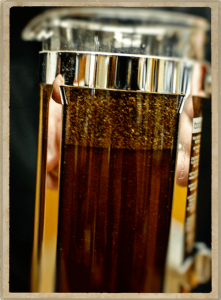
Andrew Tucker-MacLeod, our West Coast Trainer & Educator, writes about various home brewing methods and the different experiences they deliver.
All coffee brewing methods employ some filtration to separate the grounds from the finished brew and are designed to control the time which water is in contact with the grounds. Separation of the finished brew can occur at different times depending on what brew method is employed.
Each of these variables will affect the following parts of the finished coffee:
Cup Body:
How viscous the brew feels. Some descriptors may include syrupy, thin, creamy, heavy.
Cup Acidity:
What fruit-like qualities are present in the brew? We can encounter orange peel, green apple, raisins, to name a few. Both dried and fresh fruit flavors and other plant-based sugars can be identified or are present in many coffees.
Cup Aftertaste:
The remaining impressions of the brew can be described as lingering, rough, soft, dry, short. Filtration comes in many forms, from woven fabrics to metal screens and paper filters of various shapes. Each of these factors contribute to cup quality by their regulation of the water flow over the bed of coffee and the filtrations ability to separate fine particles and heavier oils from the finished brew.

Each filter needs a specific range of coffee particles to optimally brew for any given method. The brew method will determine the length of extraction time. Automatic brewers can finish 40 ounces of coffee in 4-5 minutes from start to finish, and French Presses are typically plunged around 4 minutes. These two very different brewers have one thing in common: the time water is in contact with ground coffee. To determine the time we should leave coffee and water together, let us examine the shapes and kinds of brewers and their filters. In doing so, we can easily categorize them by design. Some types of extraction are steeping, steep and release, and gravity-driven by force of water delivery on the bed of coffee.
French Press: A cylindrical beaker with multiple metal filters on a plunger. The coffee floats in water, making this a simple steeping method. The plunger uses two perforated metal disks to sandwich a fine mesh screen which upon pushing through the beaker of brewing coffee catches the majority of coffee particles and traps them at the bottom of the beaker. The resulting coffee will continue to soak the cake of grounds unless decanted or served immediately after plunging. Metal mesh requires coarse ground coffee to be effectively trapped and separated from the finished coffee. Due to this factor, brewing with a French Press will take 4 minutes to properly soak into the coarse particles and the resulting brew will have a heavy body (due in part to the remaining small particles suspended in the cup). Another factor influencing cup body are the concentration of oils, acids, and sugars present in this brew. Metal cannot absorb these qualities, therefore 100% of these extracted compounds are present in the cup. The acidity of French Pressed coffee will be muted due to the abundance of these compounds paired with the concentration of suspended coffee particles interacting with our taste buds.

A cup of French Press coffee will generally exhibit a long aftertaste, also due to the high concentration of compounds lingering after drinking. Read Part II where we look at the Clever Dripper, the Hario v60 Cone, and the Kalita Wave.
